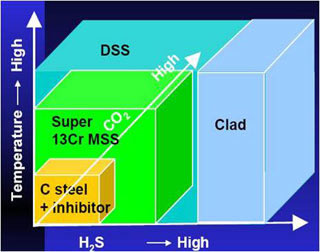Co2 Corrosion Modeling
OSG can assist in corrosion modeling, who have an excellent understanding of all the mechanisms that need to be considered when specifying corrosion allowances and selecting materials.
The majority of CO2 modeling programs currently, being used in the oil and gas industry have severe limitations, which can easily lead to misinterpretation of results.
Some of the more important aspects related to corrosion modeling are highlighted below.
The general overall philosophy for the material selection is based on: 
- System design life
- Internal & external corrosion prevention
- Material cost (Investment, Operation and Life Cycle Cost)
- Fabrication
- In-service inspection
- Maintenance
- Reliability/operability
- Safety and environment
- Repair and cost of failure
Operating and maintenance strategies impact the suitability of certain material selection choices. For instance, some systems need to be designed to last for the life of the field with little or no maintenance intervention or protection. In other cases, components which are readily accessible may be designed for periodic replacement. In such cases the design, including isolation and accessibility to the component, must reflect the maintenance strategy.
- Internal Corrosion Evaluation
- Corrosion Mechanisms
- Modeling Assumptions
The evaluation of the corrosivity of the production fluid shall include as a minimum the following:
- CO2 Content
- H2S Content
- Organic Acids
- pH
- Oxygen content and content of other oxidizing agents
- Operating temperature and pressure
- Halide, metal ion and metal concentration
- Velocity, flow regime and sand production
- Biological activity
- Condensing conditions
- Corrosion Mechanism
Sweet corrosion is caused by the presence of Carbon Dioxide (CO2) dissolved in water to form carbonic acid (H2CO3). The chemical formulas below illustrate the mechanism.
| CO2 + H2O —› H2CO3 | Equation 1 |
| H2CO3 —› HCO3- + H+ | Equation 2 |
| Fe —› Fe2+ + 2e- | Equation 3 |
Corrosion increases as the concentration of CO2, system pressure and temperature increases. This corrosion is typically slow, localized and results in pitting attack. Pits are very difficult to detect because of their tiny size and the corrosion products that cover them. At higher temperatures, typically above 70 degrees centigrade, the corrosion rate may slow down due to the formation of iron carbonate scaling.
The objective of corrosion modeling is to calculate expected corrosion rates for carbon steel and verify that the chosen wall thickness for the subsea flowlines and equipment is sufficient to withstand the effects of internal corrosion over the design life of the development.
If the CO2 corrosion modeling calculations indicate the need for a corrosion allowance in excess of 8 mm over the design life of the system when using chemical inhibition, corrosion resistant alloys are recommended to prevent CO2 corrosion.
There are a significant number of variables that need to be determined before the materials selection process can be completed and these include, operating pressure, temperature, pH, H2S, CO2, Cl-, oxygen concentration, bicarbonates (HCO3-), etc.
If this information is incomplete (or uncertain), the materials engineer is forced to be conservative regarding materials selection. For example, the Cl- content will have a significant impact on the risk of cracking and the bicarbonate concentration will affect the pH and therefore the corrosion rate, in particular the CO2 corrosion rate.
If no information is available regarding pH and Cl- level, the following assumptions can be considered;
- For gas production; pH = 3.5 and chloride concentration = 1 g/L NaCl for condensation water and 200 g/L NaCl for formation water.
- For oil production; pH = 4.5 and chloride concentration = 165 g/L NaCl (100 g/l dissolved chloride).
